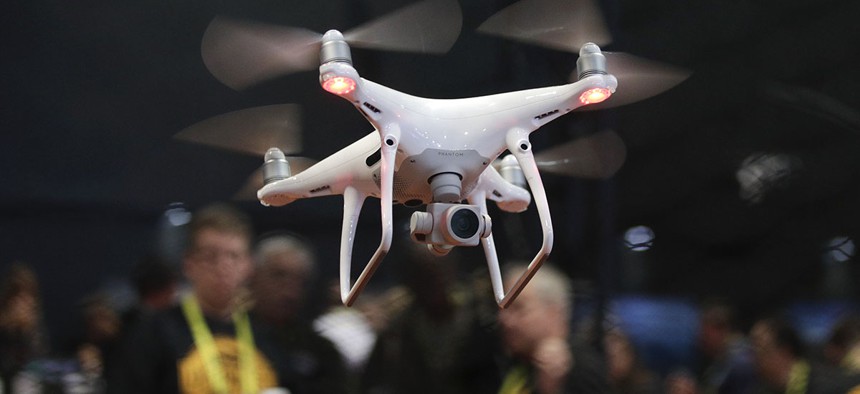Will Your Next Job Be Piloting Drones?

An exhibitor demonstrates a drone flight at CES International Thursday, Jan. 5, 2017, in Las Vegas. Jae C. Hong/AP
With commercial use expected to surge, would-be operators have more options for training.
Last year, the Federal Aviation Administration released its requirements for flying drones that weigh under 55 pounds. The rules state the pilot must keep the drone in sight at all times, not exceed 100 miles per hour, and operate the drone only during daylight hours. Pilots must also report accidents that result in an injury.
While the list of rules for operating a drone is long and detailed (read the whole thing here), the requirements for becoming a drone pilot are relatively simple. You need to be at least 16 years old. You also need to pass a written test. After that, you can fly a registered drone. And it’s becoming increasingly possible to find work that will pay you for this skill.
From their origins in the military, drones are now appearing in many different industries, including real estate, filmmaking and advertising. Companies such as Amazon and Google are testing ways to deliver packages via drone in the future, although federal rules for commercial drone delivery are not yet in place, and some cities are moving to restrict drone use.
A 2013 report released by a trade group, the Association for Unmanned Vehicle Systems International, projected more than 100,000 new jobs in unmanned aircraft by 2025. Analysts at PricewaterhouseCoopers predicted last year that the global market for commercial applications of drone technology could reach $127 million by 2020.
To match the demand for jobs that require a person to know how to operate a drone, training programs are popping up at universities and institutes across the country. The Phoenix-based Unmanned Vehicle University is one school that focuses on training drone pilots. UVU offers graduate degrees in unmanned systems engineering as well as hands-on pilot training courses.
Tuition for UAV (unmanned aerial vehicle) pilot certification costs between $3,500 and $4,000, and students don’t need a college degree or any prior experience with drones. UVU, which is for-profit, teaches groups from the public sector (military units, police departments and federal agencies) and private companies as well as individual students.
CityLab spoke to Paul Dragos, dean of the School of Flight Training at UVU, about the process of becoming a drone pilot.
What got you interested in drones?
First, it’s a huge, ballooning industry. We’re at a point now where, whether we like it or not, drones are going to become part of our everyday life, very similar to automobiles. So I’m excited to get involved in an industry that’s just going to be a huge part of our society. Second is the aviation part. As an ex-Navy pilot, I’ve always been attracted to aviation and flying. It was a very good fit.
What’s your role at the university?
I manage instructors located around the country and they all report to me. Almost all of our instructors have at least 10 years of experience with radio-controlled aircraft and drones. I also set up special training sessions for police departments and military units.
You manage the program to earn a UAV pilot certificate. What is the process for that?
There’s three steps. The first step is a set of videos, and it’s close to 16 hours of online videos. Each segment is about 20 minutes and at the end of that is a quiz.
The videos will get you familiar with aspects of drones: for example, airspace limitations, flight, how drones work, weather conditions, and more. Once you complete that part, you are sent a simulator that hooks up to your computer. The simulator has a controller that looks exactly like a drone controller. You go through about 12 hours of tasks. When you pass that, you meet with an instructor in person. The hands-on training is typically two days long.
Once a person earns a certificate, do they need to meet other requirements with the FAA?
You are required to have a drone pilot license—that’s called FAA 107. Our university has a couple of courses on how to prepare for taking the 107 test.
Do you see people wanting to become a drone pilot as a second career option?
It’s all across the board. We get students of all ages. We have teenagers who play video games, middle-aged people who are looking for a career change, and people with aviation experience. Some students have a modest interest, while others have huge goals with large numbers of drones for an organization.
Is there a good job market out there?
Absolutely. There are huge numbers of jobs out there. The number is just going to grow. There are literally hundreds of different uses for drones in the industry. The boundaries are limitless.
Do students have specific requests?
It’s very flexible and very student-focused. That is why we keep it one-on-one. We can accommodate just about any request from the student. Some students will come in and say, “I’ve never flown a drone,” or “I’ve flown a drone but I want to learn new skills.” Other students will say, “I’m applying for a specific job where I’ll be inspecting cellphone towers. Can you teach me how to do a proper inspection of a cellphone tower?” We do have that capability. One of my instructors is a cinematographer and drone pilot in Hollywood. I send any student who is interested in filmmaking or cinematography to that instructor.
Have you seen an increase in people signing up for drone training?
On Aug. 29, the FAA came out with the requirements to operate a drone. We’ve seen an increase pretty much every month since.
NEXT STORY: Former OMB Controller To Join Deloitte





